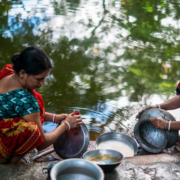Archive | Gender RSS feed for this section
Gender, Social development and protection, Transport
 Gender, Health, Social development and protection
Gender, Health, Social development and protection
 Environment, Gender
Environment, Gender
 Gender, Social development and protection
Gender, Social development and protection
 Gender, Social development and protection
Gender, Social development and protection
 Gender, Social development and protection
Gender, Social development and protection
 Gender, Social development and protection
Gender, Social development and protection
 Finance sector development, Gender
Finance sector development, Gender
 Education, Gender, Sanitation
Education, Gender, Sanitation
 Gender, Poverty, Social development and protection
Gender, Poverty, Social development and protection

Silent Struggles: Advancing Women’s Mobility with Public Transportation in Asia

Find out what is holding women back from using public transport in Asia and how can governments break down these barriers.
Enhancing access to maternal and newborn healthcare in developing Asia

The health of mothers and newborns can reveal important clues about the quality and accessibility of healthcare services.
Gender equality at the heart of climate resilience

The journey toward achieving the Sustainable Development Goals hinges upon a gender-inclusive perspective.
Fighting the trafficking of women and children in Asia

Trafficking is often considered a gender-based harm, as women and children are more likely to face this form of exploitation.
Ending discrimination and building SOGIESC-inclusive societies

People with diverse sexual orientations, gender identities, gender expressions, and sex characteristics continue to experience stigma and discrimination, stemming from deeply rooted cultural and societal norms and religious views.
Uncovering women’s burden of “unseen” work

Unpaid contributions to production and consumption in households remain excluded from the narrow economic definition of work but are essential to welfare.
Putting an end to the social disease of domestic violence

Domestic abuse is not a minor problem but a public health disease that affects millions of women around the globe.
Global survey points to progress on financial inclusion but stubborn gender gaps in Asia

Asia has seen steady overall progress on financial inclusion, but gender gaps are still growing in some countries.
Does sanitation access improve schooling outcomes for girls and boys?

All the sanitation improvement projects and investments over the years beg the question of whether we have seen a significant increase in school enrollment and gender parity in education or not. While most empirical studies on sanitation focus on the relationship between sanitation and health, recent studies have now looked into the downstream impacts of sanitation on other development indicators, such as those related with education and gender.
How can trade liberalization boost women’s employment and well-being? An analysis of the Thai labor market

As the economy is a gendered structure, trade liberalization affects women and men differently in various dimensions and through different channels. Trade liberalization causes structural transformation in terms of production and, therefore, leads to changes in employment patterns and income. However, the effect of trade is heterogenous across different sectors.


Search
Subscribe / Connect to Asia Pathways
Subjects
- Agriculture and natural resources
- Blog
- Capacity development
- Climate change
- Economics
- Education
- Energy
- Environment
- Finance sector development
- Gender
- Governance and public sector management
- Health
- Industry and trade
- Information and Communications Technology
- Infrastructure
- Miscellaneous
- Population
- Poverty
- Private sector development
- Regional cooperation and integration
- Sanitation
- Social development and protection
- Transport
- Uncategorized
- Urban development
- Video Blog
- Water
Recent Posts
- Navigating Linear Transport Infrastructure Through Conservation Landscapes
- How Are Technology Trends Shaping the Future of Insurance?
- Securing Asia’s Future Through Soil Health: Why It Matters and What Must Be Done
- Silent Struggles: Advancing Women’s Mobility with Public Transportation in Asia
- Mind Your Neighbors: Measuring Shrimp Farm Spillovers




Recent Comments